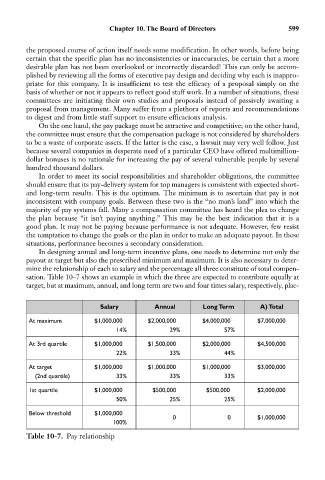Page 613 - Bruce Ellig - The Complete Guide to Executive Compensation (2007)
P. 613
Chapter 10. The Board of Directors 599
the proposed course of action itself needs some modification. In other words, before being
certain that the specific plan has no inconsistencies or inaccuracies, be certain that a more
desirable plan has not been overlooked or incorrectly discarded! This can only be accom-
plished by reviewing all the forms of executive pay design and deciding why each is inappro-
priate for this company. It is insufficient to test the efficacy of a proposal simply on the
basis of whether or not it appears to reflect good staff work. In a number of situations, these
committees are initiating their own studies and proposals instead of passively awaiting a
proposal from management. Many suffer from a plethora of reports and recommendations
to digest and from little staff support to ensure efficacious analysis.
On the one hand, the pay package must be attractive and competitive; on the other hand,
the committee must ensure that the compensation package is not considered by shareholders
to be a waste of corporate assets. If the latter is the case, a lawsuit may very well follow. Just
because several companies in desperate need of a particular CEO have offered multimillion-
dollar bonuses is no rationale for increasing the pay of several vulnerable people by several
hundred thousand dollars.
In order to meet its social responsibilities and shareholder obligations, the committee
should ensure that its pay-delivery system for top managers is consistent with expected short-
and long-term results. This is the optimum. The minimum is to ascertain that pay is not
inconsistent with company goals. Between these two is the “no man’s land” into which the
majority of pay systems fall. Many a compensation committee has heard the plea to change
the plan because “it isn’t paying anything.” This may be the best indication that it is a
good plan. It may not be paying because performance is not adequate. However, few resist
the temptation to change the goals or the plan in order to make an adequate payout. In these
situations, performance becomes a secondary consideration.
In designing annual and long-term incentive plans, one needs to determine not only the
payout at target but also the prescribed minimum and maximum. It is also necessary to deter-
mine the relationship of each to salary and the percentage all three constitute of total compen-
sation. Table 10–7 shows an example in which the three are expected to contribute equally at
target, but at maximum, annual, and long term are two and four times salary, respectively, plac-
Salary Annual Long Term A) Total
At maximum $1,000,000 $2,000,000 $4,000,000 $7,000,000
14% 29% 57%
At 3rd quartile $1,000,000 $1,500,000 $2,000,000 $4,500,000
22% 33% 44%
At target $1,000,000 $1,000,000 $1,000,000 $3,000,000
(2nd quartile) 33% 33% 33%
1st quartile $1,000,000 $500,000 $500,000 $2,000,000
50% 25% 25%
Below threshold $1,000,000
0 0 $1,000,000
100%
Table 10-7. Pay relationship

